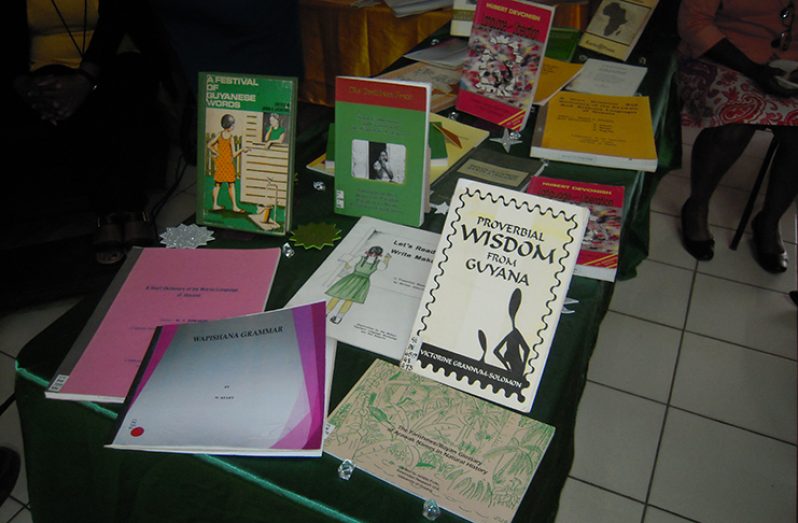By Gibron Rahim
“A NATURAL language is the archive where the experiences, knowledge and beliefs of a community are stored.”
The above words were uttered by the late Spanish linguist Fernando Lázaro Carreter. It underscores the relationship between language and identity. Guyana’s many languages are a testament to our rich culture. Language preservation needs to be one of our priorities as we move forward as individuals and as a people. Mashramani and International Mother Language Day are reminders of that.

Wednesday last marked the first time that International Mother Language Day was celebrated in Guyana. The worldwide observance is held on February 21 every year since February 2000 with its goal being to “promote linguistic and cultural diversity and multilingualism”. For us here in Guyana, it may be considered fortuitous that the occasion is so close to our Mashramani, a time when we celebrate our cultural diversity.
The event was held in the Education Lecture Theatre of the University of Guyana by the Guyana Languages Unit Working Group and the Faculty of Education and Humanities. Attendees were seated in a circle for the festivities, creating the ambience of a village gathering. Throughout the event, which lasted for over two hours, the audience was able to listen to stories and songs told in Arawak, Akawaio, Patamuna, Wapichan, Guyanese Creole (or Creolese) and English.
It was clearly evident very early on in the afternoon’s programme that it would be remiss to categorise all the Indigenous languages together into a group as such. Each of the languages spoken at the event had its own cadence and stress, its own identity. For some in attendance, it was their first time hearing those languages. From Michael Khan in his persona of ‘Ole Man Pappie’, who told a “Nancy Story” in Creolese, to Aunty Joan’s story of one of the legends of the village of Wakapoa, to name but a few of the presenters, the audience was invested to the end.
After the event, and as preparations were getting underway for the graduation of the students of the Creolese Writing class, the Pepperpot Magazine was able to speak to Charlene Wilkinson. Wilkinson, a lecturer in English at the University of Guyana, was one of the event’s organisers. She explained that she had no intentions of letting the International Mother Language Day pass by this year as it had in previous years. With Wilkinson receiving support from her colleagues, Dhaniswary Jaganath, Dr. Tamir De Lisser, Michael Khan, students of the Creolese Writing class and others, the group was able to put together the event.
Wilkinson acknowledged that the event was not as organised as it could have been. She clarified that she had put out a call for participants but that, in most cases, participants came in at the last minute. The event was thus not able to have a structured programme. This though worked in its favour for she said, “There is danger in too much planning too.”
Her dream she told the Pepperpot Magazine is to have the event continue without a rigid structure in years to come. “If people get to understand each other’s aesthetic then we will begin to learn to blend together, which, for me, is what nation-building is about,” she said. Her firm belief is that we can create unity through the arts and through similar events.
Language and identity are two concepts that are tied up in each other. Indeed, Wilkinson emphatically noted that they are inseparable. Indeed, the talk she had prepared to deliver at the graduation later that evening was titled “Not a Blade o’ Grass, Not a Word Guh Loss”. The talk’s purpose was to show the relationship between environmental preservation and language preservation.
“Our languages, especially the Indigenous languages, still carry the secrets and the knowledge and the wisdom of that relationship to the environment that the Western culture has destroyed,” explained Wilkinson. She conceded that it is true that individual words from the languages can be learnt. However, she noted that these words come with the language’s grammar, its body language and the relationship of the human body with the Earth itself. Because of that interconnectedness, cutting an Indigenous speaker off from their language also means severing that relationship to the Earth.
There is danger in relegating Creolese and the languages of the First Peoples to the background to put English at the forefront. Saying “English only” can begin the process of killing a language. Indeed, Wilkinson noted that we have evidence of that right here in Guyana. Berbice Dutch she said had been thriving at the time Guyana changed from Dutch to British hands. The British insisted on the speaking of solely English in schools which led to the eventual demise of Berbice Dutch.
Even after the end of the colonial period and perhaps even today, as Wilkinson pointed out, Indigenous children are being admonished for speaking their mother tongue. There is a fear, she explained, that speaking their languages will prevent them from being able to learn English. However, that is simply not the case. “It is more natural for us to take on many languages,” she emphasised.
One of the most important lessons from International Mother Language Day 2018 is that all languages are valid and valuable. It is true that English enables communication with our global community. This though does not invalidate the worth of Creolese, Arawak, Akawaio, Arecuna, Carib, Macushi, Patamuna, Wai Wai, Wapichan or Warrau, and that is worth remembering.




.jpg)










